Beef Satay is one of those dishes that can be a hit or miss at Thai restaurants. If you want a sure thing, make it at home!! You’ll love the secret for how to make economical beef cuts so succulent you’d swear they’re top shelf meat. These skewers are so good you can eat them plain, but no one in their right mind would skip the Thai Peanut Sauce!
Top tip: These are excellent to grill on the BBQ, or even better, over charcoal for a truly authentic Thai experience.
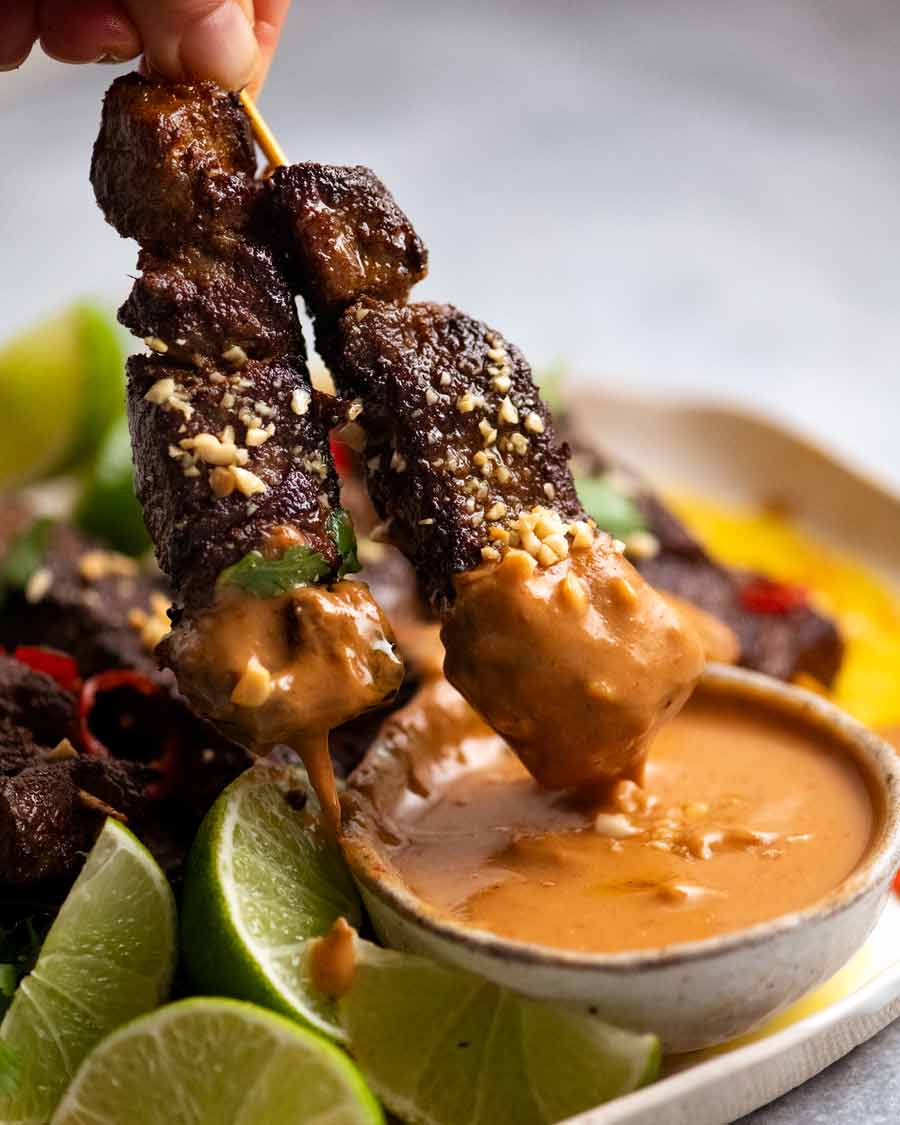

Thai Beef Satay
When I eat out at Thai restaurants, I tend to default to Chicken Satay skewers because I know chicken is hard to get wrong. Beef Satay, on the other hand, can be terribly hit or miss. Bland, chewy and dry beef is an all-too-common refrain.
To experience Beef Satay the way it’s meant to be, better to make it yourself. It’s easy to do, cheaper and you know it will hit the mark!
And what is that mark? It’s succulent pieces of beef, firstly tickled in a marinade of satay seasoning. Then they’re seared on a ripping hot skillet for charry crust while staying lovely and pink inside. To serve, the skewers are befriended by a bowl of rich and smooth Thai Peanut Sauce – the perfect counterpoint for these smoky sticks of pleasure.
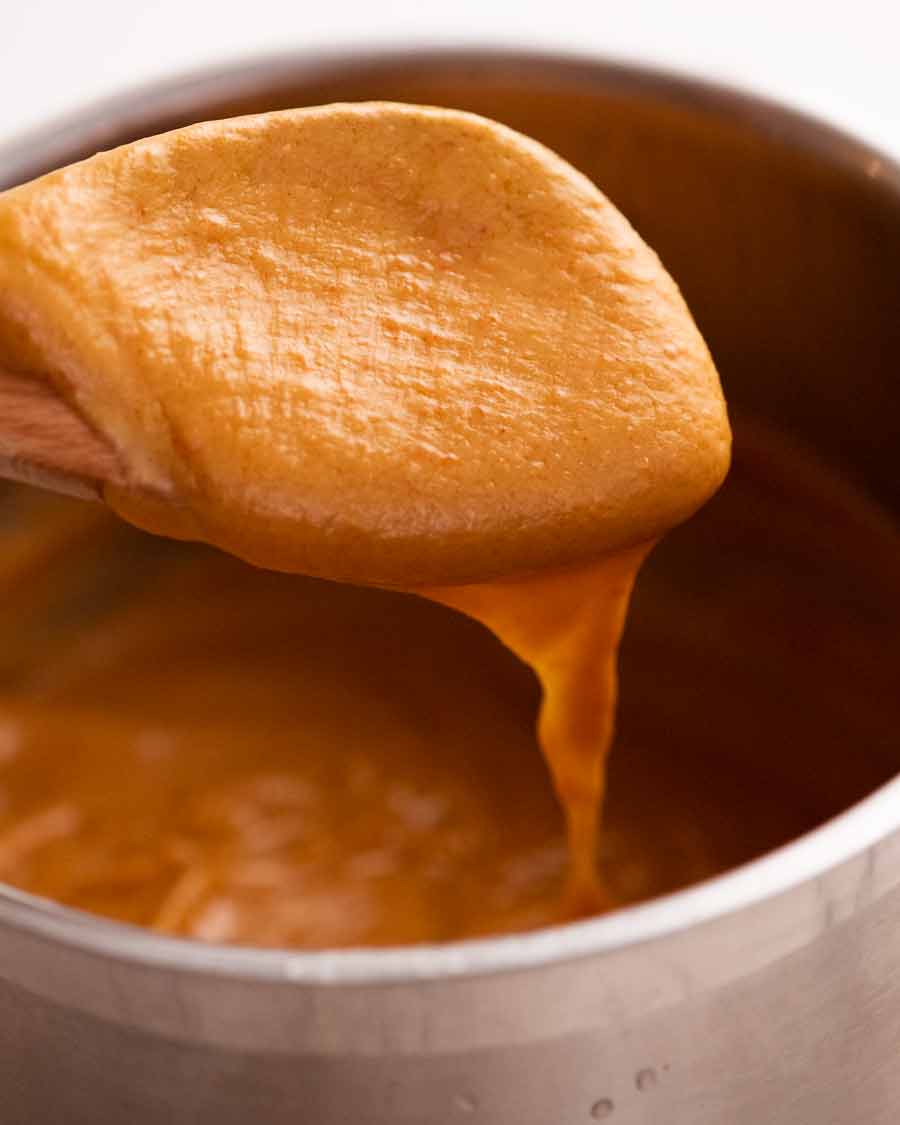
The secret for tenderising beef: baking soda / bi-carb
This Beef Satay recipe is a little bit special because it includes a handy method to tenderise a tougher beef cut so it becomes succulent, using baking soda / bi-carb. Cubes of raw beef are marinated overnight in a satay seasoning with a little baking soda added (just 1/2 teaspoon for 600g / 1.2lb of beef), then cooked in the usual manner.
The baking soda magically relaxes the meat fibres, making the beef more tender without changing the texture of the beef itself. It’s based on a method used by Chinese restaurants called velveting. Here’s the velveting recipe covering the technique in detail. The Chinese method is applied to thinner strips of beef, uses more baking soda and a shorter marinating time (~40 minutes to 1 hour). The baking soda is also rinsed off before cooking. The result is soft, “velvet”-like texture, hence the technique name.
For this Thai Beef Satay however, I specifically want to keep the original texture of beef intact so I use less baking soda and marinate overnight. The amount is so small too it cannot be tasted.
The result? Succulent pieces of beef that you’d swear are from a premium cut! The added bonus is that it’s also virtually impossible to overcook baking soda-tenderised beef.
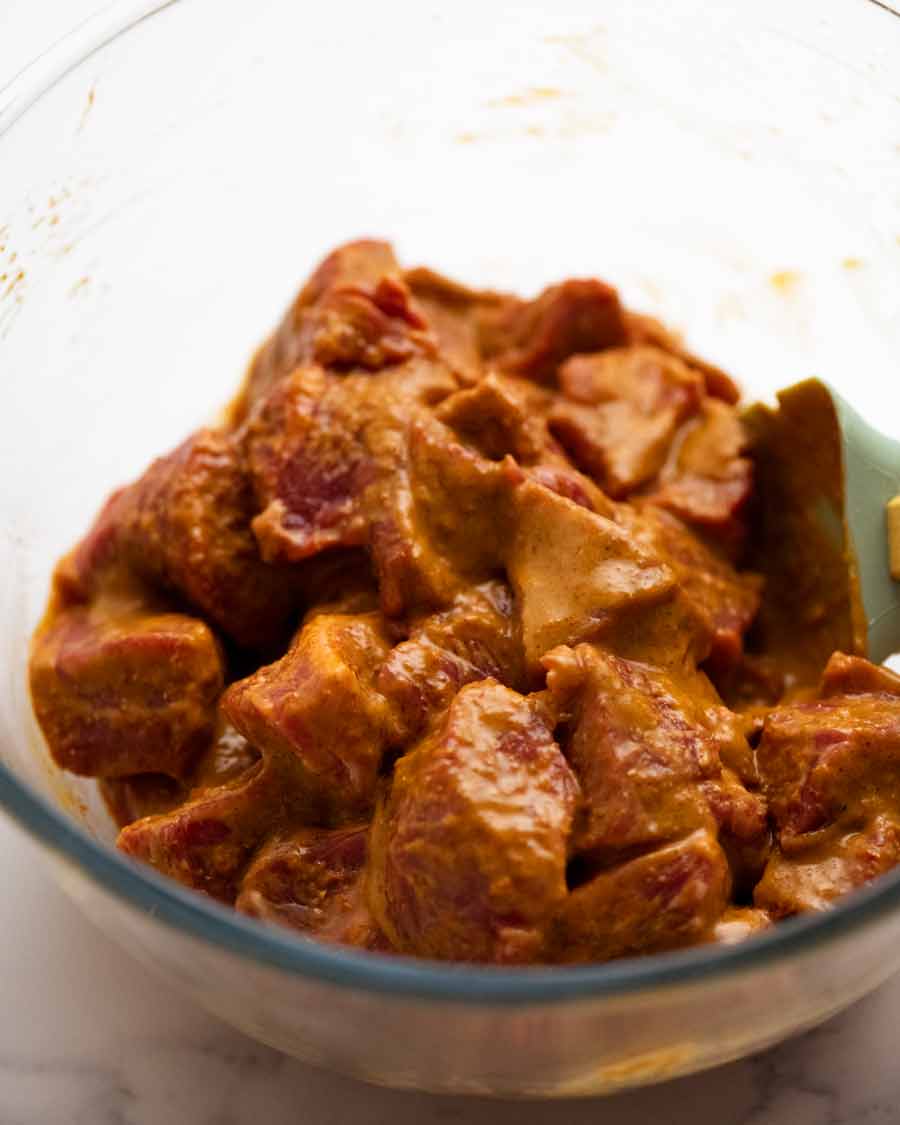
Marinating beef for Thai Beef Satay 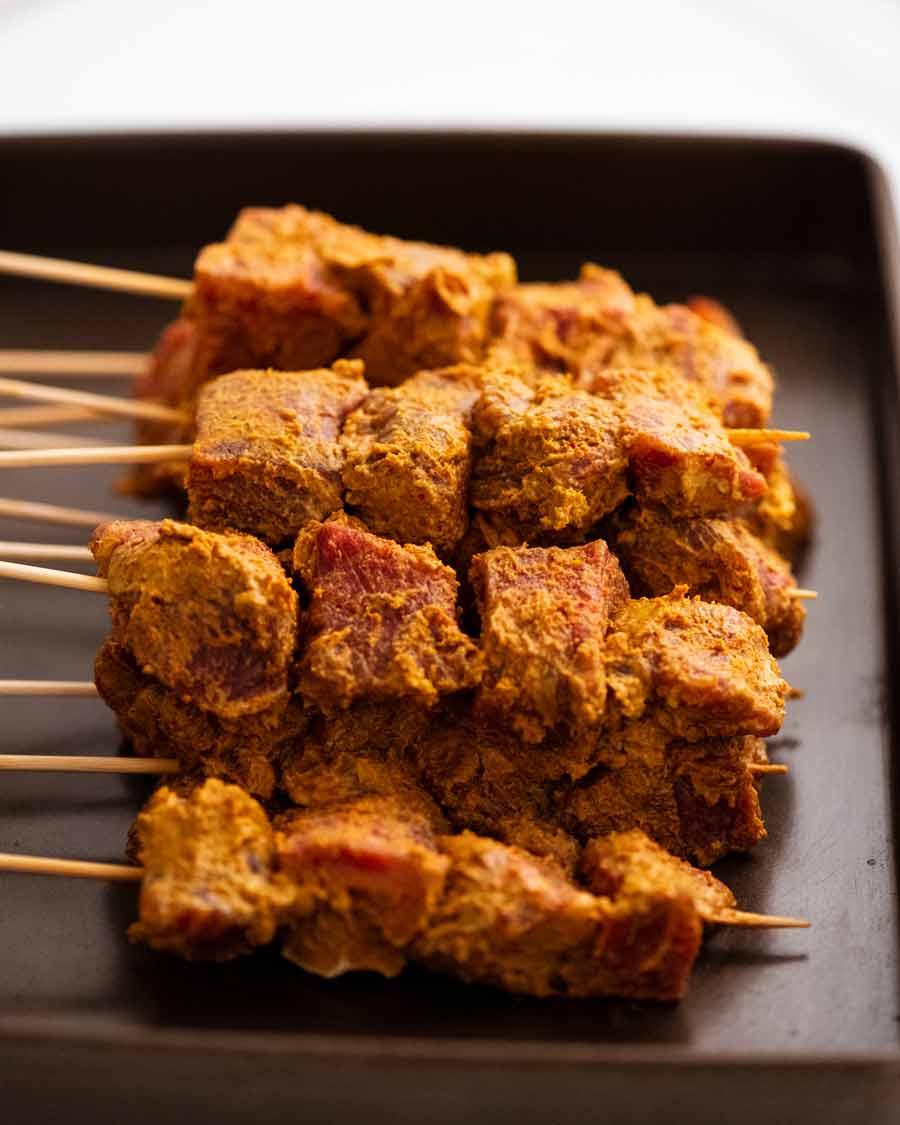
Beef Satay skewers ready to cook
Ingredients in Thai Beef Satay
In this section, I’ve separated the ingredients as follows:
Beef Satay marinade; and
Thai Peanut Dipping Sauce.
1. Ingredients for Beef Satay Marinade with tenderiser
Here’s what you need for the beef and satay marinade:
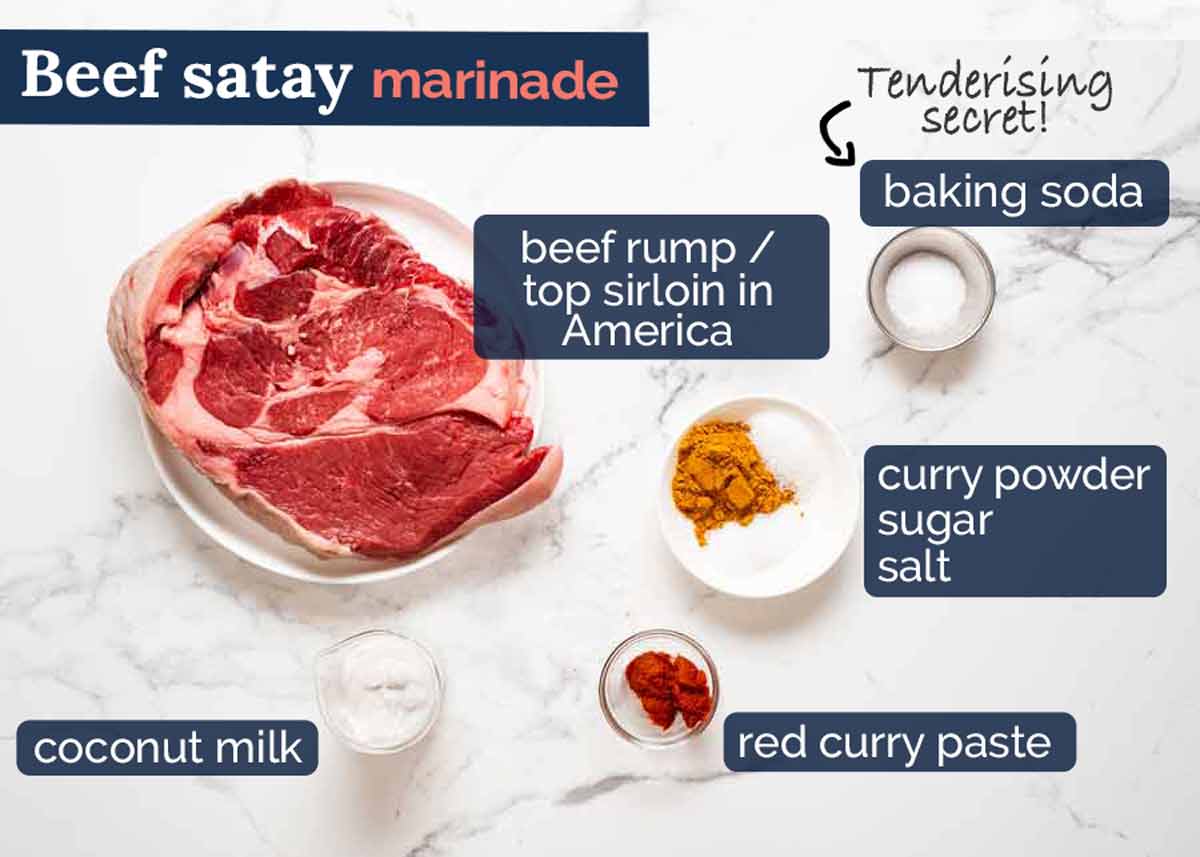
Just a quick run down on some of the ingredients:
Beef – I like to use rump steak (top sirloin is the equivalent in the US) which I then tenderise using baking soda/bi-carb, as outlined in the above section. This is a good mid-price cut of beef that’s got good beefy flavour and holds its shape will in neat cubes when cooked. It can be a little chewy though, making it an ideal candidate for marinating overnight with baking soda to tenderise it.
Feel free to use a more tender – and more expensive – cut of beef such as scotch fillet / boneless rib eye. If you do, skip the baking soda as obviously there’s no benefit to tenderising the beef further. And take care not to overcook it!
Baking soda / bi-carb – As explained in the section above, baking soda / bi-carb is the magic ingredient that tenderises tougher cuts of beef in this recipe;
Thai red curry paste – This is an essential and key flavouring in Thai satay, for both the beef marinade and in the peanut sauce, because it’s packed with a ton of umami (the food nerd term for savoury flavour). You could make your own curry paste, but because this recipe only calls for 3 tablespoons, I tend to just use store-bought.
My recommended red curry paste brand is Maesri, pictured below. It comes in small cans, and is very cheap (~$1.25). It’s available at large grocery stores here in Australia (Coles, Woolworths, Harris Farms) as well as Asian grocery stores. The flavour is far superior (in my opinion) to other mainstream curry pastes.
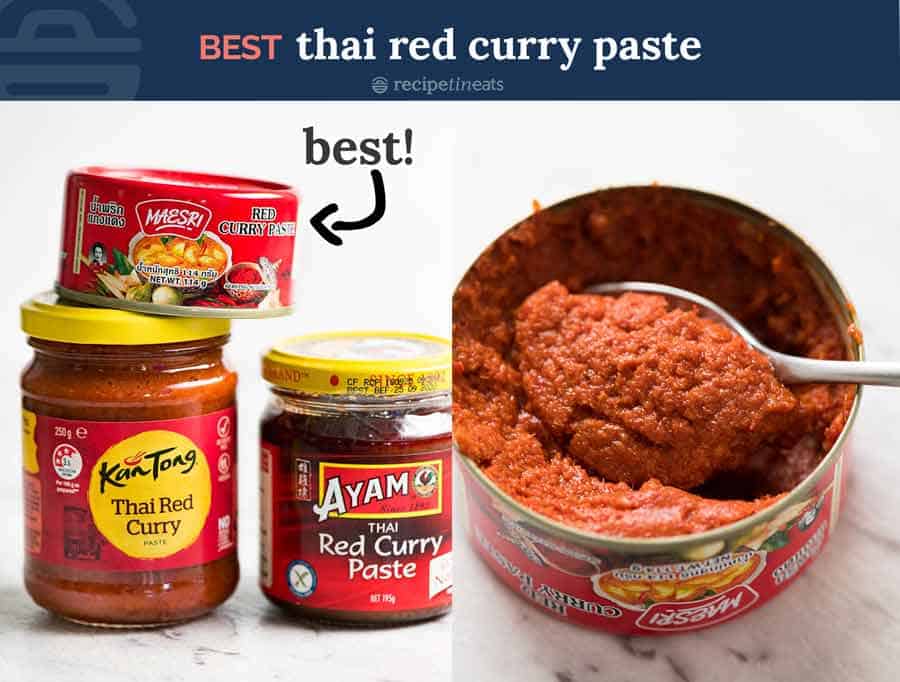
Coconut milk – Not all coconut milk is created equal. Cheaper brands are diluted with water and contain less actual coconut, and in turn less coconut flavour and fats. I recommend Ayam brand, which is 89% coconut kernel extract (some other brands are as low as 53%!) You can use low fat coconut milk, but I won’t condone it! 😂
Leftover coconut milk – The recipe doesn’t use a full can, so freeze leftovers if you don’t have an immediate use for it. Else click here for other recipes using coconut milk.
Curry powder – Curry powder is the other flavouring in satay. It’s a background flavour so there’s no need to use a specific type. Any generic “curry powder” is fine here. I use Clives or Keens (mild, not hot).
2. Thai Peanut Sauce
And here’s what you need for a restaurant-style Thai Peanut Sauce!
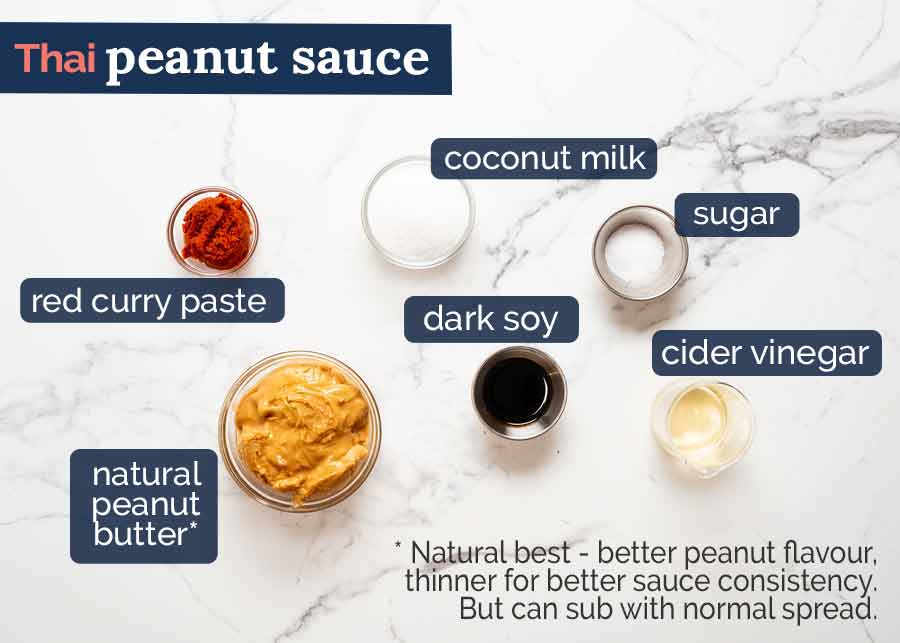
Red Curry Paste – This is the key flavouring in Thai Peanut Sauce so I really do urge you to try to get Maesri, the recommended brand shown in the above section! But if you can’t, any Thai Red Curry Paste you can get will do;
Natural Peanut Butter – This is the type of peanut butter typically sold in the health food aisle in grocery stores. It is different to mass-market stuff in that it has no added sugar, salt or other preservatives. It also has a stronger peanut flavour and is thinner than sweetened peanut butter (eg Kraft or Bega). This means better flavour in the sauce and makes the sauce the right consistency.
Commercial peanut butter spreads by contrast are thicker and the peanut flavour is not as good. So you need to use more to achieve the same flavour, which makes the sauce thicker than is ideal. That said, commercial peanut butter does work just fine as a substitute!
Dark soy sauce – This adds salt to the sauce as well as making the sauce a darker colour. If you don’t have it, light soy sauce or all-purpose soy sauce is fine to use too. The sauce will be a bit paler;
Cider vinegar – Plenty of alternatives here, we just need a vinegar to add tang to balance out the flavour in the sauce;
Coconut milk – The primary liquid in Thai Peanut Sauce. As with the marinade, good brands with high coconut content are what you want (check label ingredients). I use Ayam. And don’t talk to me about low fat coconut milk!
How to make Thai Beef Satay
1. Thai Peanut Sauce
The peanut sauce is a plonk-and-simmer job:

Plonk all the ingredients in a medium saucepan over medium low heat; and
Simmer for 5 minutes, whisking occasionally so the base doesn’t catch.
As I said, it’s a simple “plonk and simmer”!!
2. How to make Thai Beef Satay
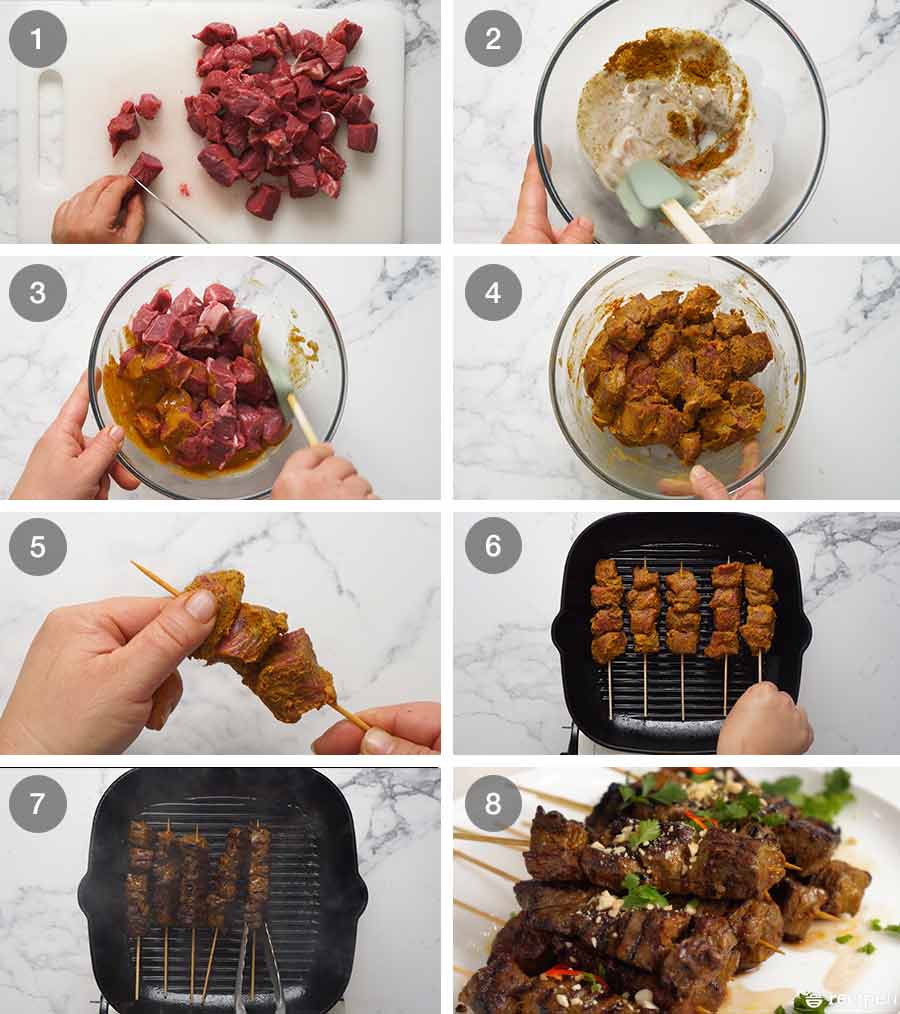
Cut beef into 2.5cm / 1″ cubes.
Mix Satay Marinade ingredients in a bowl.
Mix beef into the Satay Marinade.
Marinate beef for 24 hours. For this recipe, I don’t recommend reducing the marinating time so as to ensure the baking soda has sufficient time to properly tenderise the beef.
Thread beef on to skewers. I like to use short skewers that fit inside a skillet. Typically I’ll thread 4 cubes on each skewer, but if I’m serving as an appetiser to pass around then I might only do 3.
Cook skewers on the stove in a griddle pan or skillet – or better still, barbecue them – over high heat. For the most authentic Thai street food experience, cook it over charcoal!
Turn skewers to cook each side (ie all 4 sides) until nicely charred and cooked through to medium well done which takes around 8 to 10 minutes. It’s important to know that beef that’s been tenderised with baking soda only becomes tender once thoroughly cooked. If it’s medium rare, then the beef will be on the chewy side because we’re using an economical cut of beef. Yes this is the exact opposite of all the rules you read about cooking steak!!
An even more amazing fact out beef tenderised using baking soda is that it’s virtually impossible to overcook. In fact, even when cooked to well done, it will still be pink inside!
Rest the skewers for 3 minutes before serving. To add some colour and visual appeal, garnish with a dusting of finely chopped peanuts, coriander/cilantro and finely sliced red chilli (use large ones so they aren’t spicy).
And of course, don’t forget the peanut sauce!!
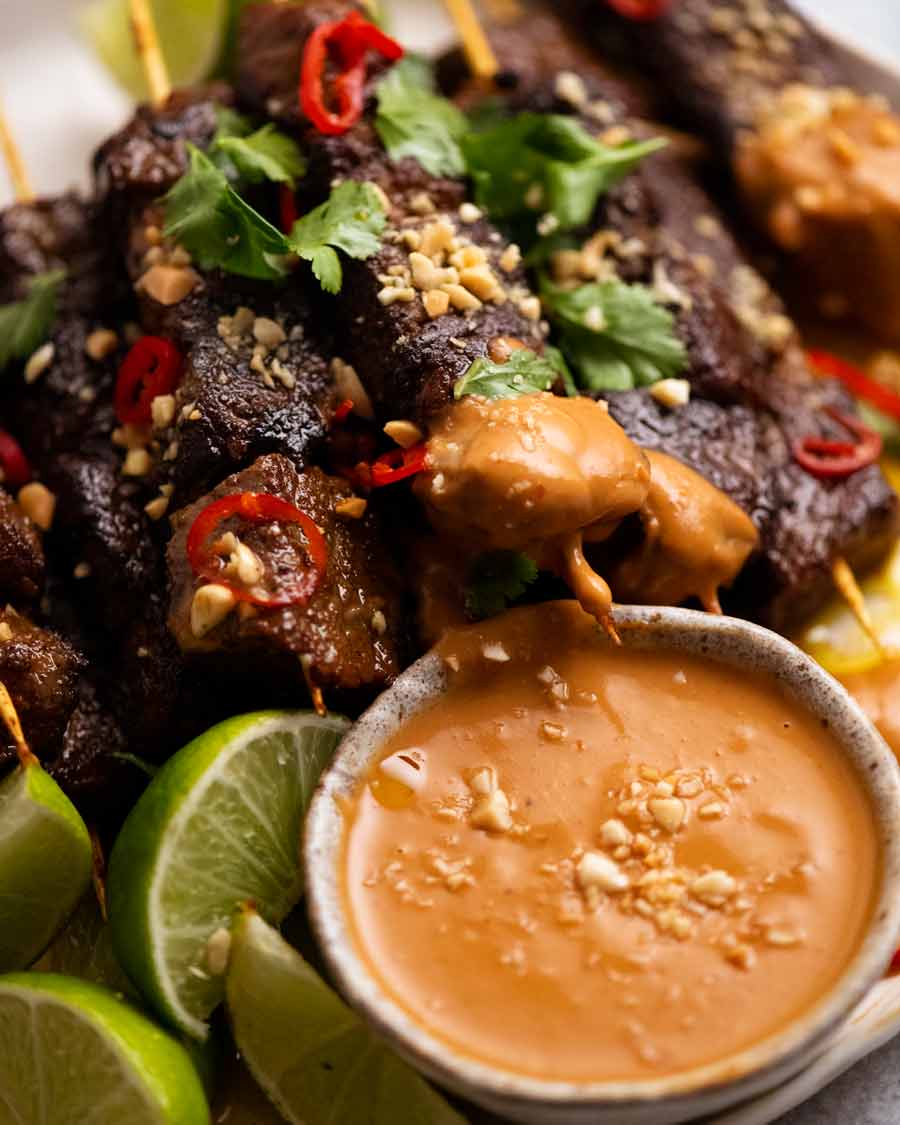
It’s truly impossible to properly capture how tender the beef is in a photo or even in a recipe video!
Notice how pink the beef is inside, even though this is cooked through to medium. That’s the baking soda at work here – the beef stays pink even when cooked beyond medium rare. This is typical with some types of tenderised beef, such as Korean Beef Galbi.
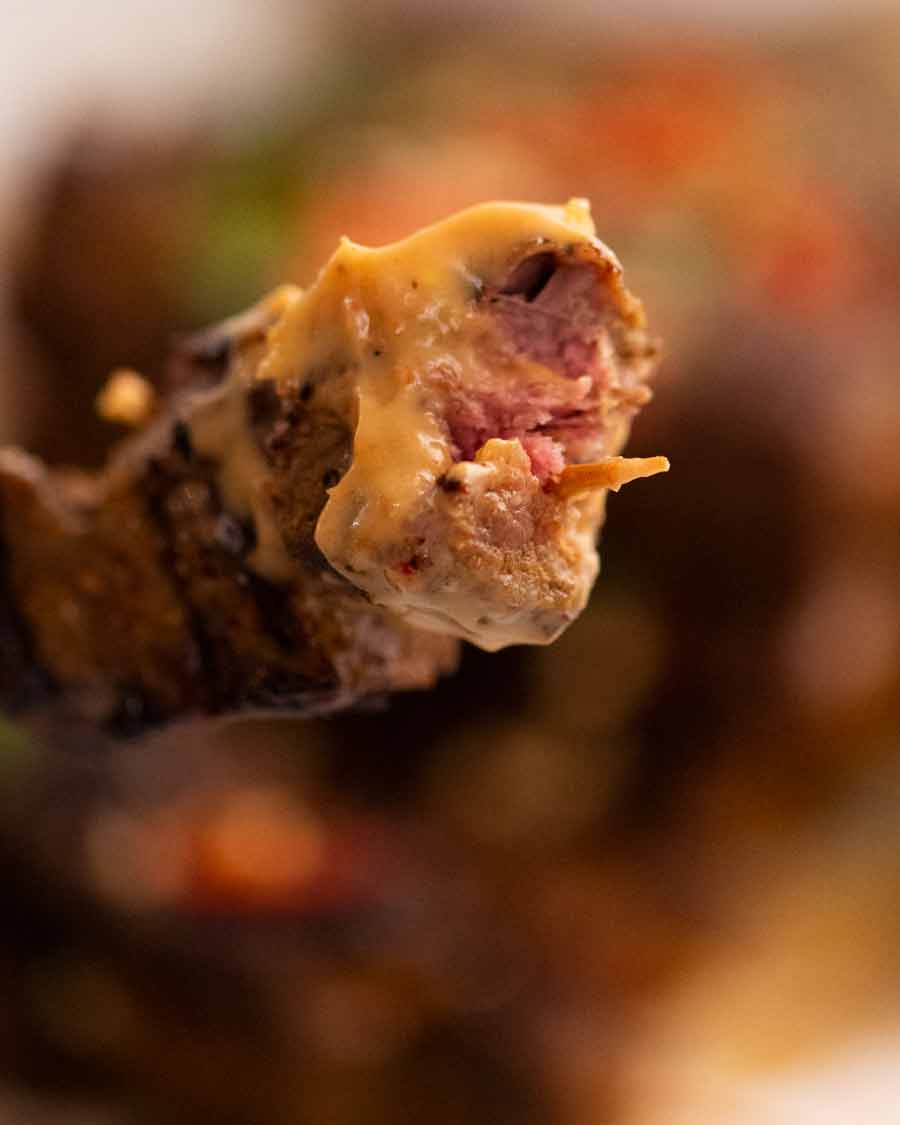
What to serve with Thai Beef Satay
Beef Satay is typically listed as a starter at Thai restaurants. However, more often than not, it forms part of a main course when I make it. Asian BBQ is a firm favourite menu theme when I have friends over!
Here’s a few suggestions for things to serve on the side, or as a starter:
Thai Fish Cakes – A popular starter at Thai restaurants, with a Sweet Chilli Dipping Sauce;
Thai Lettuce Wraps – The Thai version of Chinese lettuce wraps, with a beautiful lemongrass-flavoured chicken or pork mince filling;
Rice options – Jasmine rice is the traditional rice served in Thailand. Plain is fine because you’ll douse it with peanut sauce! Else try Thai Fried Rice or Pineapple Fried Rice;
Salad options – A cooling Thai Green Papaya Salad is classic! Meanwhile, some other options for you: Smashed Cucumber Salad with a Ginger Dressing (personal favourite!); Asian Slaw; Asian Side Salad. Then of course, my standard fallback for all things Asian, possibly Australia’s favourite salad : Chang’s Crispy Noodle Salad (it’s a back-of-the-packet life essential!).
Enjoy! – Nagi x
Watch how to make it
Hungry for more? Subscribe to my newsletter and follow along on Facebook, Pinterest and Instagram for all of the latest updates.

Beef Satay with Thai Peanut Sauce
Ingredients
- 13-16 bamboo skewers , 16cm / 6.5" long (Note 1)
Marinade:
- 600g / 1.2lb beef rump steak (top sirloin in the US) , 2.5 cm/1" pieces (Note 2)
- 1/4 cup coconut mik , full fat (I use Ayam, Note 3)
- 1 tbsp curry powder (Note 4)
- 1 tsp white sugar
- 2 tsp red curry paste (Note 5)
- 1/2 tsp baking soda / bi-carb (tenderiser, Note 6)
- 1 tsp salt
Thai Peanut Sauce:
- 1 tbsp red curry paste (Note 5)
- 2/3 cup coconut milk , full fat (I use Ayam, Note 3)
- 1/3 cup natural peanut butter , smooth (Note 7)
- 1 1/2 tbsp white sugar
- 1 tsp dark soy sauce (Note 8)
- 1/2 tsp salt
- 1 tbsp cider vinegar (Note 9)
- 1/3 cup water
Cooking & Serving:
- 1 1/2 tbsp vegetable oil , for cooking
- 2 tbsp peanuts , finely chopped
- Lime wedges (optional)
- Coriander / cilantro leaves and sliced red chilli (optional)
Instructions
- If cooking on a BBQ or over charcoal, soak skewers for 2 hours in water so they don't burn.
Thai Beef Satay Skewers:
- Mix together the beef and Marinade in a bowl. Cover with cling wrap and marinate overnight (do not reduce marinating time else the beef may not tenderise enough).
- Thread onto skewers – I do 4 pieces each.
- Heat 1.5 tbsp oil in a large non stick pan over medium high heat.
- Cook 10 minutes (yes, well done!): Cook skewers in batches for 2 to 2 1/2 minutes on all 4 sides until deep golden (total of 8 to 10 minutes) and fully cooked through. (Note: baking soda tenderised beef needs to be thoroughly cooked to be tender. The beef is still a bit chewy if it's medium or less.)
- Rest: Transfer skewers to plate and rest for 3 minutes before serving with Peanut Sauce.
Thai Peanut Sauce:
- Place all Peanut Sauce ingredients in a small saucepan over medium low heat.
- Stir to combine then simmer, stirring every now and then, for 5 minutes. Adjust consistency with water – it should be a pourable but thickish sauce.
- Remove from stove, cover with lid and keep warm while cooking skewers.
Serving:
- Pour sauce into a bowl. Sprinkle with some peanuts – stir some through if you want.
- Pile satay skewers onto a platter, sprinkle with remaining peanuts, coriander and chilli.
- Serve with sauce on the side for dipping. Add a side of Jasmine Rice or Thai Fried Rice or Pineapple Fried Rice to complete the meal!
Recipe Notes:
- Thai Chicken Satay
- Gado Gado (Indonesian Salad with peanut sauce)
- Sauce for for rice, noodles, veggies (raw or steamed)
- Dip for prawn crackers and vegetables
- As the dressing for this Chinese Chicken Salad, Satay Noodle Salad, Peanut Noodle Salad or Sesame Noodles
Nutrition Information:
Life of Dozer
My iPhone likes to offer “Moments” such as “One year ago today”. This is what it showed me:

Clearly I picked Dozer up from the boarder on this day last year!
It also showed me this 😖:

And this:

3 photos that perfectly capture this day last year!

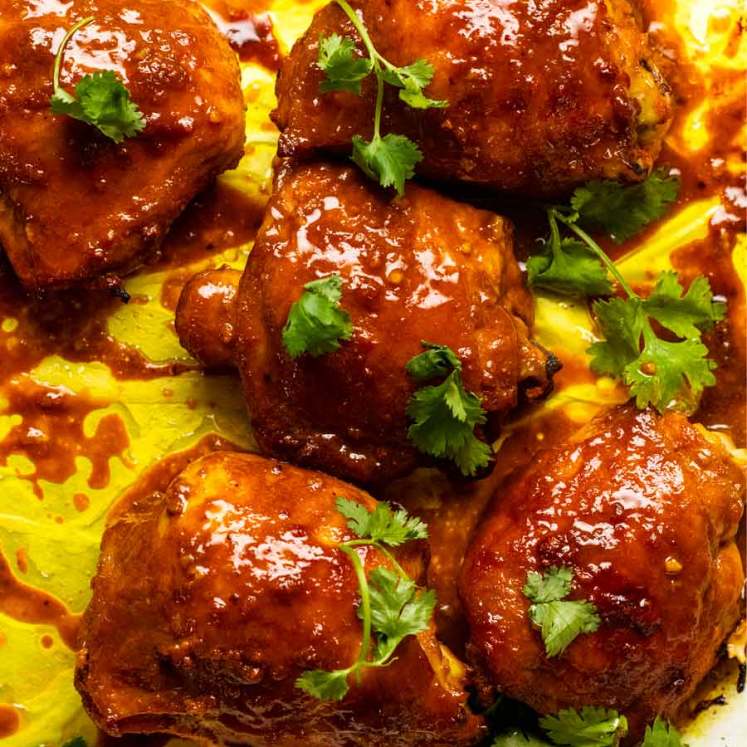


Hi Nagi,
Thank you for this recipe. Do you think I can use Panang curry paste instead of the red curry?
Another delicious recipe! Could you freeze this at the marinade stage?
I wouldn’t suggest freezing tenderised beef, sorry. N x
Oh man, this was so good. SO GOOD. My mother is Singaporean, so she’s very picky with satay and peanut sauces and she was impressed with this. The peanut sauce is perfect! Super easy and and I love how easy it was to put together.
We also added mushrooms and eggplant to the skewers.
OMG. Flavour explosion and the meat was even more tender than I imagined.
So funny story. I was purchased all the ingredients yesterday, made the marinade this morning only to realise when I put the last ingredient in, I put chilli jam instead of the red Thai paste!! Oh well, I ended up adding the Thai paste, so we’ll see how turns out tonight,
I made your Beef Satay w Tahi Peanut Sauce with Blade Steak and wow, how unbelievably tender!!! I won’t be making any more stews after this recipe – it was delicious and fam loved it! Thank you 🙂
Hi Nagi,
Always like to give feedback when I use one of your recipes. Had been drooling over this one since the email & finally made it this weekend. Delicious as always. It’s such a relief to be able to depend on your recipes every time. Added some chicken to the mix last minute when a couple unexpected guests showed up and there were rave reviews from everyone. Another reliable (& very yummy!) recipe. Will definitely be adding this one to the fave dishes list. Thank you again.
Hands down the best satay sauce I’ve ever had! Our family all love Thai food and satay is my husbands favourite. Chicken is a usual go to for satay but this beef satay is just way too delicious. I’m grateful that it is so simple to make because there is no way my family will want any other satay other than this one from now on!! Amazing Nagi! Thank you 😊
I plan to make Beef Satay, can you freeze the beef cubes in the marinade to be ready to cook in a few days.
Holy Moly this recipe was dead set amazing. Juicy tender beef skewers and the peanut sauce was to die for! Will be making these again.
Absolutely delicious! This is quickly becoming a weekly favourite. I use a standard sized rump steak and get about 6 skewers with four meat cubes on each skewer. The bicarb really does the trick of tenderising the meat.
Hi Nagi! Love your recipes. Is this 182 calories per skewer?
Hi Jason, this recipe makes 12 skewers, nutrition is for 1 skewer and one serving of sauce. N x
One of my favourite foods to order when eating Thai. Cannot believe how delicious this recipe is. Tried it with chicken as well as beef. I can’t decide which I liked more
Thank you Nagi for this recipe. I had a GF vegan dinner party – used this marinade on firm tofu (minus the bicarb) and used Ayam red curry paste (endorsed by coeliac society) and GF soy sauce. Then put the tofu skewers on the BBQ. It worked perfectly! Thank you.
Hi, can the beef be subbed for chicken in this recipe, for a cheaper alternative?
Sure can Angus – I actually link the chicken skewer recipe in this post! https://www.recipetineats.com/thai-chicken-satay-peanut-sauce/ N x
Hey Nagi! I absolutely love allll your recipes, not had a bad one yet 😃.
Quick question, I don’t like the flavour the bio carb seems to give to the meat, am I using too much, or would baking powder be a better option?
Hi Sharon! You shouldn’t be able to taste it with the small amount used in this recipe with all the flavour in the marinade. Any chance yours is past the due date or has been left open? If it goes off it can add a slight metallic taste to anything it’s used in (including baked goods). N x
Ohhhh, that’s totally what’s happened!! Thanks for the advice xxx
Nagi this sauce is extraordinary!! absolutely beyond any Satay House wow. I had most of the ingredients in the freezer that were leftovers and it turned out almost as good as yours Nagi. Yum it’s delicious but I will freeze it and make the meat another day. Loving the pics of that spoilt boy you have there, it’s not what you would call a dog’s life is it? xx
I am allergic to most nut milks and soy. Is it possible to use cow milk? Maybe skim or powdered milk? Just trying to find an alternative that will allow me to enjoy this recipe with my family.
thanks again Nagi , so good and yummy 🤤,my family loved them and so easy to cook after marinading. i will have this on rotation in our family for a long time.
I’m so glad they were a hit Belinda, that’s awesome!! N x
A quick use for the coconut milk:
Blitz coconut milk with chia seeds (white or black or mix) and a banana and refrigerate overnight for breakfast the next morning! Amazing!